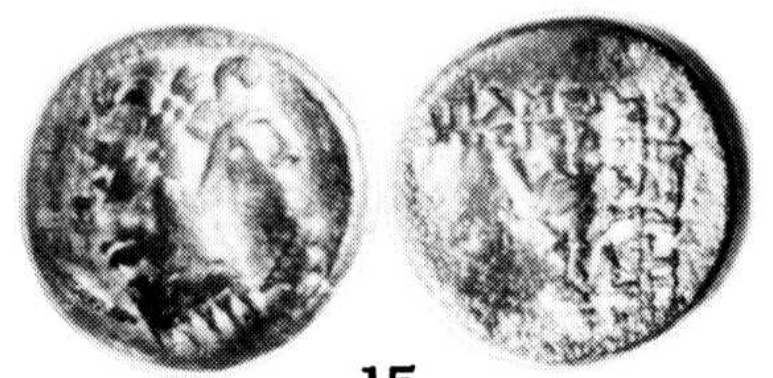80 BCE - 68 BCE | BAΣIΛEΩΣ BAΣIΛEΩN TIΓPANOY
Overstriking coin
Tigranocerta_over_Apameia_(Nercessian_1996, _n°15).PNG
Overstruck variety
Apameia_Zeus_Elephant.JPG
[1]
Description
| ObverseInscription or printing placed on the obverse.:
|
Bust of Tigranes II to right, wearing Armenian tiara decorated with a star between two eagles and tied with a diadem, drapery on shoulders. Border of dots.
|
ReverseInscription or printing placed on the reverse.:
|
BAΣIΛEΩΣ BAΣIΛEΩN TIΓPANOY Tyche of Antioch seated on rocks right, wearing turreted crown, holding palm branch. At her feet, the upper portion of the river-god Orontes swimming right. In field, letters/monograms. Border of dots.
|
Mint and issuing power
Chronology
| FromIdentifies the initial date in a range assigned in a numismatic context. 80 BCE toIdentifies the final date in a range assigned in a numismatic context.. 68 BCE
|
Hellenistic 323-30 BC  periodTime period of the numismatic object. periodTime period of the numismatic object.
|
Physical description
MetalThe physical material (usually metal) from which an object is made.: Bronze 
|
WeightWeight of the numismatic object (in grams). in grams: 9.549.54 g <br />9,540 mg <br />
|
DenominationTerm indicating the value of a numismatic object. Examples: tetradrachm, chalkous, denarius.: tetrachalkon 
|
|
| DiameterDescribes diameter of an object (in mm).: 2323 mm <br />2.3 cm <br />
|
|
References
| Coin referenceReference of the Coin:
|
Nercessian, 1995, n° 57, Nercessian, 1996, p. 48, n° 15
|
Coin series referenceReference to coin series study:
|
Bedoukian 19781Bedoukian 1978, n° 91-98 ("Antioch type", units 1, 2 and 4), Nercessian 19952Nercessian 1995, n° 48-54, Kovacs 20163Kovacs 2016, n° 124.
|
| Coin series web referenceCoin series web references:
|
|
Description
| ObverseInscription or printing placed on the obverse.:
|
Head of Zeus right, wearing laurel wreath.
|
ReverseInscription or printing placed on the reverse.:
|
ΑΠΑΜΕΑΩΝ ΤΗΣ ΙΕΡΑΣ ΚΑΙ ΑΣΥΛΟΥ Elephant right. In field, ΓΜΣ. In exergue, letters.
|
Mint and issuing power
| MintIdentifies the place of manufacture or issue of a numismatic object. ᵖ:
|
Apameia
|
Ancient regionAncient region. ᵖ
|
Syria (Seleucis and Pieria)
|
Modern countryModern country: Syria
|
AuthorityIdentifies the authority in whose name (explicitly or implicitly) a numismatic object was issued. ᵖ:
|
|
Chronology
| FromIdentifies the initial date in a range assigned in a numismatic context. 76 BCE toIdentifies the final date in a range assigned in a numismatic context.. 76 BCE
|
Hellenistic 323-30 BC  periodTime period of the numismatic object. periodTime period of the numismatic object.
|
Physical description
References
| Frequency of overstrikesFrequency of overstrikes:
|
|
Level of confidenceLevel of confidence of the identification:
|
|
| RemarksRemarks:
|
"Obv.: above and below, letters (visible on obverse: all the type; rev.: (visible on reverse: traces of elephant and legend)"
|
